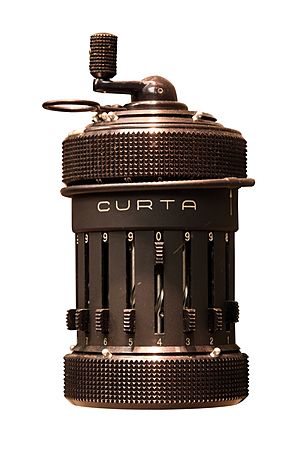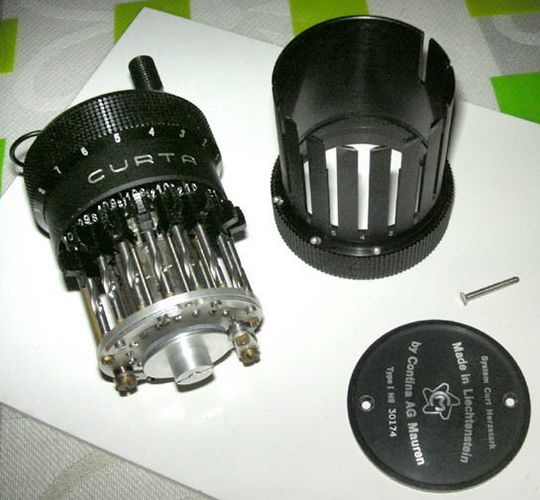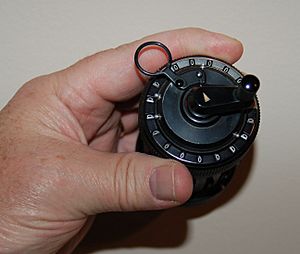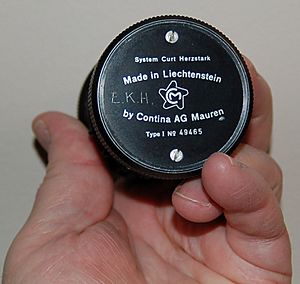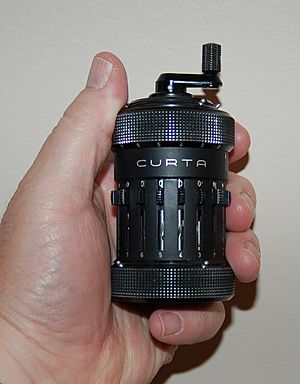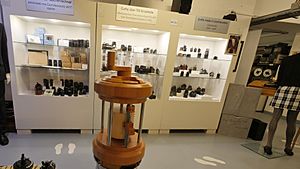Curta facts for kids
The Curta was a small, hand-held mechanical calculator designed by Curt Herzstark. It was famous for being super tiny, fitting right in your hand! People sometimes called it the "pepper grinder" or "peppermill" because of its shape. It even looked a bit like a hand grenade, so some called it the "math grenade."
Before electronic calculators became popular in the 1970s, Curtas were known as the best portable calculators you could get.
Contents
History of the Curta Calculator
The idea for the Curta came from Curt Herzstark in the 1930s in Vienna, Austria. By 1938, he had a special patent for a new part called a "complemented stepped drum." This drum was very important. It replaced many older parts found in other calculators. This new design made the Curta much smaller. It also allowed for both adding and subtracting easily.
Herzstark's work on his small calculator stopped in 1938. This was because the Nazis made his company build tools for the German army.
In 1943, Herzstark was taken to the Buchenwald concentration camp. Even there, he was encouraged to keep working on his calculator idea. He later said that continuing his work gave him hope. It helped him to keep going during a very difficult time.
While at the camp, Herzstark was able to draw detailed plans for the Curta. The camp was freed by U.S. troops in April 1945. By November, Herzstark found a factory that could build three working models.
He later moved to Austria and looked for people to help fund his invention. Franz Joseph II, Prince of Liechtenstein became interested. Soon, a new company called Contina AG Mauren started making the Curta in Liechtenstein.
Herzstark faced some challenges with his business partners. But he was able to make new agreements. This meant he still got money for his invention.
Curtas were the best portable calculators until the 1970s. That's when electronic calculators took over. Today, the Curta is a very popular item for collectors. Many old machines still work perfectly, even after 40, 50, or 60 years!
About 140,000 Curta calculators were made. This included 80,000 of the Type I and 60,000 of the Type II. The last Curta was made in 1972.
How Much Did a Curta Cost?
When they were new, a Curta Type I cost about $125. The Type II cost about $175. Only a small number of Curtas were sent back for repairs. However, some buyers tried to take their Curtas apart. Putting them back together was very hard. It needed special tools and knowledge of how each tiny part fit.
Today, these calculators are valuable to collectors. They can sell for around US$1,000. Some in perfect condition with special serial numbers can even sell for up to US$1,900.
How the Curta Calculator Works
You enter numbers into the Curta using small slides on its side. There is one slide for each digit. At the top of the machine, there are two counters. One is the revolution counter and the other is the result counter.
When you turn the crank, the number you entered is added to the result counter. The revolution counter also moves. If you pull the crank up a little before turning it, the machine will subtract instead of add. To do multiplication, division, or other math, you turn the crank and move the top part of the machine.
The Curta's design was inspired by older calculators. These include Gottfried Leibniz's Stepped Reckoner and Charles Thomas's Arithmometer.
Curta Models
The Curta Type I had eight places for you to enter numbers. It had a six-digit revolution counter. It also had an eleven-digit result counter. This model weighed about 8 ounces (230 g) (or 245 grams (8.6 oz)).
What Were Curtas Used For?
The Curta was very popular in sports car rallies during the 1960s, 1970s, and even into the 1980s. Even after electronic calculators came out, Curtas were still used in these races. They helped calculate times and distances. Early electronic calculators often broke down from the bumps and jolts of rally racing. The Curta, being mechanical, was much tougher.
Pilots also liked the Curta before electronic calculators were common. They valued its accuracy. Pilots could also check their work using the revolution counter. Calculations like weight and balance are very important for safe flying. So, getting precise results without mistakes was essential.
Curta Collections
The Curta calculator is very popular among collectors. You can find them for sale on many different websites. Peter Regenass, a collector from Switzerland, has a very large collection of mechanical calculators. He owns over 100 Curta calculators! Some of his collection is shown at the Enter Museum in Solothurn, Switzerland. In 2016, he gave a Curta calculator to the Yad Vashem Museum in Jerusalem.
Curta in Popular Culture
The Curta is mentioned in William Gibson's book Pattern Recognition (2003). In the story, it is a special piece of old computing machinery.
In 2016, a designer named Marcus Wu created a Curta that could be made with a 3D printer. However, real Curtas have very tiny, precise parts. Current 3D printers can't make parts that small and accurate. So, the 3D-printed Curta is much bigger. It's about the size of a coffee can and weighs around three pounds.
See also
 In Spanish: Curta para niños
In Spanish: Curta para niños



